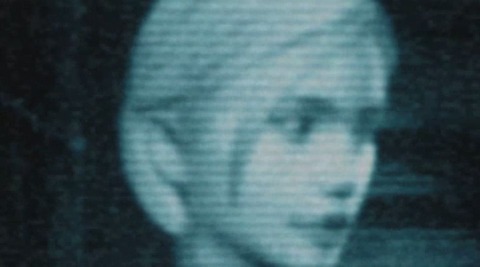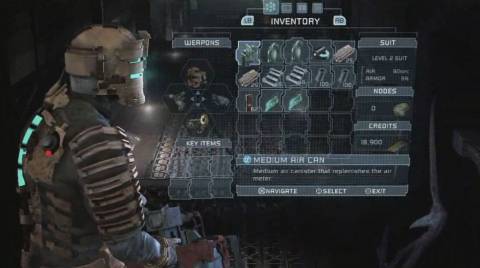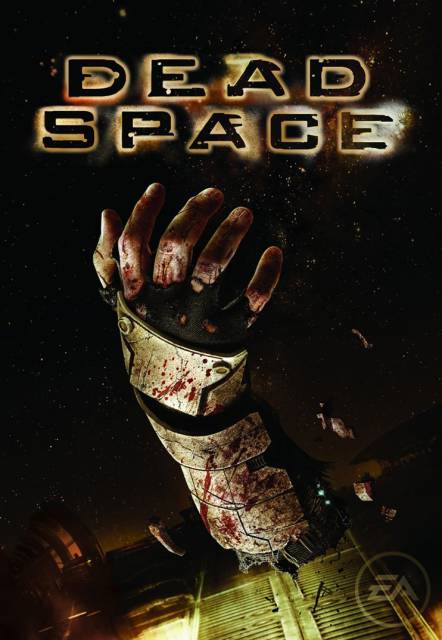An evolution in survival-horror
Dead Space is not just another Resident Evil clone; it is more than that. Yes, it may feature gameplay mechanics which are standard for the genre, pioneered by The Godfather of survival-horror; however, there are more than enough innovative, well-designed and well-executed features in Dead Space that not only allow it to set itself apart from the competition, but, also, to possibly rival it.
In Dead Space, you play as Isaac Clarke, engineer and on-board systems specialist, who has been sent out, as part of a team, to investigate a distress signal coming from the mining ship USG Ishimura. Upon discovering the Ishimura in orbit around the planet Aegis VII, Clarke's shuttle attempts to dock with the mining ship. Something goes wrong during the docking process, and the shuttle arrives at the Ishimura with more than a bump and a few bruises. With the shuttle badly damaged, Clarke and the other crew members begin their investigation of the Ishimura. They find the ship's primary systems in critical condition; worse than that, with the Ishimura severally damaged, the ship is at grave risk of being destroyed by an asteroid belt close-by. But even that isn't the really bad news; no, the really bad news is that deformed, alien monsters - called Necromorphs - roam the corridors and bulkheads of the ship, threatening everybody on board.
Dead Space's story is heavily influenced by science-fiction films, from the philosophically dense Solyaris, to the rather trashy, pulpy Wes Anderson 'classic', Event Horizon. Even Isaac's name pays homage to two great science-fiction authors, Isaac Asimov and Arthur C. Clarke. Along the way there is also quite an obvious dig at religious cults but, more specifically, Scientology. The element of religious fanaticism works well within the context of the story but ultimately seems a little shoe-horned, begging to be noticed for the parallels between it and the aforementioned cult.

Referring to Solyaris, Clarke's crewmates suffer from hallucinations of loved ones while aboard the Ishimura, and Clarke is frequently contacted by his wife, a previous occupant of the Ishimura. As you are contacted by her, the player is supposed to feel some kind of emotional attachment; frankly, though, without any dialogue on Isaac's part, it feels very one-sided, shallow and not very persuasive. On the other hand, the more occult, hellish elements borrowed from Event Horizon function better within the context of the action-oriented gameplay.
There are a few twists to keep the player entertained - one which is blindingly obvious, another which is not so. In general, the story is enough to keep the player moving but doesn't inspire much intrigue through the course of the game. Much of the story is communicated through abandoned text logs, audio logs, video logs and various transmissions from your crewmates. Some of these logs are interesting, adding to the haunting and foreboding atmosphere of this abandoned ghost ship; others are just rather dull reports made by crew members or engineers, and they do nothing apart from boring the player into skipping past them.
Gameplay is similar to Resident Evil 4's over-the-shoulder, third-person perspective - except that you can shoot and move at the same time, surely a monumental achievement for the survival-horror genre? You are armed with a variety of weapons, some of which you acquire throughout the game, and others, you can buy through the in-game store using in-game credits. Each weapon has a standard and secondary fire function, and each, its own strengths and weaknesses. Along with your standard arsenal, you also have the use of a TK Module (similar to Half-Life 2's gravity gun) and the Stasis Module, which can isolate objects and slow them down - very useful for certain puzzles and quick moving enemies. All of your equipment, including your suit, can be upgraded using the in-game store.
Much has been made of the 'strategic dismemberment' aspect of the gameplay, and rightly so. There have been games before this - for example, Soldier of Fortune - which have had this sort of gameplay, but never before has it been made an integral part of the experience. Contrary to most games, there is no central 'weak point' that must be aimed at; to successfully kill the Necromorphs you must, instead, aim for their out-lying extremities, decapitating their limbs off, one by one. If it sounds a little masochistic, then that's because it is, but it's a very clever twist on the conventional video-game maxim of 'aiming for the heart'.
Although mostly you will be fighting through the corridors and rooms of the ship, there are also instances where you are forced into spaces where the gravity is offline, or where the life-support has been damaged. These areas often provide some of most tense encounters of the game.
The zero-gravity arenas you have to navigate, from time-to-time, often form the basis of the more interesting puzzles in the game. Unfortunately, you are not alone in being able to fly around these areas; the Necromorphs can also use these areas to ambush you, and they don't seem to have a problem with the lack of a fixed orientation.
The oxygen-deprived regions of the ship provide Isaac with an incentive to carry out his objectives quickly - asphyxiation being an unfortunate side-effect of failing. The sound design, again, shows its cunning in muting all noise in these areas to a kind of echo, like being underwater.
One of Dead Space's greatest (and smallest) achievements is its HUD interface, which allows the player to organise their inventory, look at the map, check objectives and browse through archived logs - all in real-time. The inventory management screen is brought up as a kind of semi-transparent, holographic interface, which allows the player to fiddle around with ammo and health packs without having to resort to pausing the action. The effect of this is three-fold: it prevents the player's immersion in the game being broken; it makes the player feel more vulnerable; and, it encourages the player to be cautious. All of this is conducive to creating an atmosphere of claustrophobic suspense.

Another interesting aspect - related to the HUD - is the 'Breadcrumbs' function, where a faint, holographic line will appear on the floor, pointing the way to your next objective. The upside of this is that you will never be stuck with questions of where to go or what to do, and that really is a tremendous way of cutting down on time and frustration. The downside is that it reinforces the reality of the game being very on-the-rails and closed-off in terms of its level design. There isn't the sense of freedom you might have in Resident Evil, where there are usually multiple paths to explore and your objectives are uncertain. As a result, in that game there was always a sense of exhilaration as you explored the next area, as you never knew what you would find, or what challenges awaited you. Here, that sense of exploration is diminished, but you also never have to experience that sinking feeling, as you realise you're going to have to backtrack through the same level (for the second or third time). As you can see, there are costs and benefits to this sort of approach.
But, of course, a game like this would be nothing if not for its graphics and sound design. Dead Space looks fantastic; the enemy designs are delectably grotesque, and the shadow work is excellent - contributing to the nightmarish ambience. Isaac, himself, looks splendid in his technological-advanced suit-of-arms, and the internal architecture of the Ishimura is reminiscent of the Nostromo from Alien: cold, dark, grimy and metallic. The only issue is that while the ship does look like what one would imagine it, it does lack the colourful imagination of Resident Evil's haunted mansions, debris-filled streets and secret laboratories. Much of the game's levels do look quite samey, and so, consequently, it can get a little bland wondering around the same shadow-infested corridors again and again. This is a small gripe though, and I do think that the monotonous repetition of a dark colour palette is entirely consistent with the drab, dull concept of a mining ship. The same criticism could be levelled at Doom 3, but the fact is that military installations and industrial bases aren't going to look like colourful Meccas of bright colours and outrageous Nouveau design.
The use of sound in Dead Space is impeccable. There is a notable lack of a background score for the majority of the game, as you will only hear the ticking of an elevator descending, the engines whirring or the hum of electrical equipment. This almost total blanket of silence accentuates the heightened atmosphere of the game, and is only punctuated with sharp audio shrieks as Necromorphs jump out of air vents, around corners from ceilings and, even, from floors. When there is a set-piece in the game, the audio picks-up and the music gradually swells in the background accordingly. After Isaac has killed the last monster in the room, the music will slowly lower in volume to nothing, and all you are left with is Isaac's erratic respirations.
Another aspect worth mentioning is that the game does its best to make you feel Isaac's pain as he is injured and, sometimes, killed. While Isaac is mute throughout the entire game, he shows more than enough emotion through his grunts and screams as you get pummelled, beaten, thrown about and decapitated. Isaac isn't the stoic warrior; if he gets hurt then, boy, is he going to let you know it. And the death scenes...wow, are they ever hilariously gruesome.
Dead Space is both clever and exciting as a survival-horror game. Throughout my time playing it, I rarely felt bored or frustrated, and many of the innovations it fields are welcome additions to fast-becoming stale genre. I think the main issue with the game - and which really stops it from achieving greatness - is that it is lacking in terms of its setting and the universe it creates. Simply put, it's just not that interesting, and it lacks the colourful scope and imagination of the Resident Evil universe. The hinting towards a greater menace, in the form of the religious cult 'Unitology', feels a bit too much like beating a dead horse. It was a cliché in Doom 3; it is just as bad a cliché here.
If the makers of Dead Space come up with something slightly more original for its inevitable sequel - instead of just borrowing from various well-known sources - maybe then I'd feel like returning to the Dead Space universe. As it is now, though, I've had my fill.
